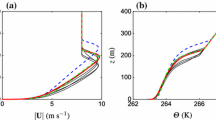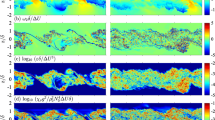Abstract
Geophysical boundary-layer flows feature complex dynamics that often evolve with time; however, most current knowledge centres on the steady-state problem. In these atmospheric and oceanic boundary layers, the pressure gradient, buoyancy, Coriolis, and frictional forces interact to determine the statistical moments of the flow. The resulting equations for the non-stationary mean variables, even when succinctly closed, remain challenging to handle mathematically. Here, we derive a simpler physical model that reduces these governing unsteady Reynolds-averaged Navier–Stokes partial differential equations into a single first-order ordinary differential equation with non-constant coefficients. The reduced model is straightforward to solve under arbitrary forcing, even when the statistical moments are non-stationary and the viscosity varies in time and space. The model is successfully validated against large-eddy simulation for, (1) time-variable pressure gradients, and (2) linearly time-variable buoyancy. The new model is shown to have a superior performance compared to the classic Blackadar solutions (and later improvements on these solutions), and it covers a much wider range of conditions.



Similar content being viewed by others
References
Albertson JD, Parlange MB (1999) Natural integration of scalar fluxes from complex terrain. Adv Water Resour 23:239–252. doi:10.1016/S0309-1708(99)00011-1
Baas P, Van de Wiel BJH, Van den Brink L, Holtslag AAM (2012) Composite hodographs and inertial oscillations in the nocturnal boundary layer. Q J R Meteorol Soc 138:528–535. doi:10.1002/qj.941
Banta RM, Newsom RK, Lundquist JK, Pichugina YL (2002) Nocturnal low-level jet characteristics over Kansas during CASES-99. Boundary-Layer Meteorol 105:221–252
Blackadar A (1957) Boundary layer wind maxima and their significance for the growth of nocturnal inversions. Bull Am Meteorol Soc 38:283–290
Bonner W, Paegle J (1970) Diurnal variations in boundary layer winds over the South-Central United States in summer. Mon Weather Rev 98:735–744
Bou-Zeid E, Meneveau C, Parlange M (2005) A scale-dependent Lagrangian dynamic model for large eddy simulation of complex turbulent flows. Phys Fluids 17:25105. doi:10.1063/1.1839152
Buajitti K, Blackadar AK (1957) Theoretical studies of diurnal wind-structure variations in the planetary boundary layer. Q J R Meteorol Soc 83:486–500. doi:10.1002/qj.49708335804
Du Y, Rotunno R (2014) A simple analytical model of the nocturnal low-level jet over the Great Plains of the United States. J Atmos Sci 71:3674–3683. doi:10.1175/JAS-D-14-0060.1
Ekman VW (1905) On the influence of the Earth’s rotation on ocean-currents. Ark Mat Astron Fys 2:1–52
Garratt J (1994) Review: the atmospheric boundary layer. Earth Sci Rev 37:89–134. doi:10.1016/0012-8252(94)90026-4
Gayen B, Sarkar S, Taylor JR (2010) Large eddy simulation of a stratified boundary layer under an oscillatory current. J Fluid Mech 643:233. doi:10.1017/S002211200999200X
Grisogono B (1995) A generalized Ekman layer profile with gradually varying eddy diffusivities. Q J R Meteorol Soc 121:445–453
Hering W, Borden T (1962) Diurnal variations in the summer wind field over the Central United States. J Atmos Sci 19:81–86
Hsu BC, Lu X, Kwan M (2000) LES and RANS studies of oscillating flows over flat plate. J Eng Mech 126:186–193
Huang J, Bou-Zeid E (2013) Turbulence and vertical fluxes in the stable atmospheric boundary layer. Part I: a large-eddy simulation study. J Atmos Sci 70:1513–1527. doi:10.1175/JAS-D-12-0167.1
Israeli M, Orszag SA (1981) Approximation of radiation boundary conditions. J Comput Phys 41:115–135. doi:10.1016/0021-9991(81)90082-6
Kumar V, Svensson G, HoltslagAAM Meneveau C, Parlange MB (2010) Impact of surface flux formulations and geostrophic forcing on large-eddy simulations of diurnal atmospheric boundary layer flow. J Appl Meteorol Climatol 49:1496–1516. doi:10.1175/2010JAMC2145.1
Lewis DM, Belcher SE (2004) Time-dependent, coupled, Ekman boundary layer solutions incorporating Stokes drift. Dyn Atmos Ocean 37:313–351. doi:10.1016/j.dynatmoce.2003.11.001
Lohmann IP, Fredsøe J, Sumer BM, Christensen ED (2006) Large eddy simulation of the ventilated wave boundary layer. J Geophys Res 111:C06036. doi:10.1029/2005JC002946
Madsen OS (1977) A realistic model the wind-iduced Ekman boundary layer. J Phys Oceanogr 7:248–255
Mahrt L (2013) Stably stratified atmospheric boundary layers. Annu Rev Fluid Mech 46:23–45. doi:10.1146/annurev-fluid-010313-141354
Mahrt LJ, Schwerdtfeger W (1970) Ekman spirals for exponential thermal wind. Boundary-Layer Meteorol 1:137–145. doi:10.1007/BF00185735
McNider RT (1982) A note on velocity fluctuations in drainage flows. J. Atmos. Sci. 39:1658–1660
Miles J (1994) Analytical solutions for the Ekman layer. Boundary-Layer Meteorol 67:1–10. doi:10.1007/BF00705505
Momen M (2016) Mean and turbulence dynamics of atmospheric boundary layers: large-eddy simulations and reduced analytical models. Ph.D. thesis, Princeton University
Momen M, Bou-zeid E (2017) Mean and turbulence dynamics in unsteady Ekman boundary layers. J Fluid Mech 816:209–242. doi:10.1017/jfm.2017.76
Momen M, Bou-Zeid E (2016) Large eddy simulations and damped-oscillator models of the unsteady Ekman boundary layer. J Atmos Sci 73:25–40. doi:10.1175/JAS-D-15-0038.1
Nunalee CG, Basu S (2013) Mesoscale modeling of coastal low-level jets: impliactions for offshore wind resource estimation. Wind Energy 17:657–669
Orszag SA, Pao YH (1974) Numerical computation of turbulent shear flows. Adv Geophys 18:225–236
Poulos GS, Blumen W, Fritts DC, Lundquist JK, Sun J, Burns SP, Nappo C, Banta R, Newsom R, Cuxart J, Terradellas E, Balsley B, Jensen M (2002) CASES-99: a comprehensive investigation of the stable nocturnal boundary layer. Bull Am Meteorol Soc 83:555–581. doi:10.1175/1520-0477(2002)083<0555:CACIOT>2.3.CO;2
Radhakrishnan S, Piomelli U (2008) Large-eddy simulation of oscillating boundary layers: Model comparison and validation. J Geophys Res Ocean 113:1–14. doi:10.1029/2007JC004518
Schröter JS, Moene AF, Holtslag AAM (2013) Convective boundary layer wind dynamics and inertial oscillations: the influence of surface stress. Q J R Meteorol Soc 139:1694–1711. doi:10.1002/qj.2069
Shapiro A, Fedorovich E (2010) Analytical description of a nocturnal low-level jet. Q J R Meteorol Soc 136:1255–1262. doi:10.1002/qj.628
Shibuya R, Sato K, Nakanishi M (2014) Diurnal wind cycles forcing inertial oscillations: a latitude-dependent resonance phenomenon. J Atmos Sci 71:767–781. doi:10.1175/JAS-D-13-0124.1
Tan ZM (2001) An approximate analytical solution for the baroclinic and variable eddy diffusivity semi-geostrophic Ekman boundary layer. Boundary-Layer Meteorol 98:361–385. doi:10.1023/A:1018708726112
Tennekes H, Lumley J (1972) A first course in turbulence. MIT, Boston, 300 pp
Thorpe AJ, Guymer TH (1977) The nocturnal jet. Q J R Meteorol Soc 103:633–653. doi:10.1002/qj.49710343809
Van de Wiel BJH, Moene AF, Steeneveld GJ, Baas P, Bosveld FC, Holtslag AAM (2010) A Conceptual view on inertial oscillations and nocturnal low-level jets. J Atmos Sci 67:2679–2689. doi:10.1175/2010JAS3289.1
Vincent CL (2010) Mesoscale wind fluctuations over Danish waters. Ph.D. thesis, Denmark Technical University
Yordanov D, Syrakov D, Djolov G (1983) A barotropic planetary boundary layer. Boundary-Layer Meteorol 25:363–373. doi:10.1007/BF02041155
Acknowledgements
The authors acknowledge support from the Physical and Dynamic Meteorology Program of the National Science Foundation under AGS-1026636, and from the Cooperative Institute for Climate Science of Princeton University and the National Oceanographic and Atmospheric Administration under Grant Number 344-6127. The simulations were performed on the computing clusters of the National Centre for Atmospheric Research under Project Number P36861020.
Author information
Authors and Affiliations
Corresponding author
Appendix: Particular Solutions in Polar Coordinates
Appendix: Particular Solutions in Polar Coordinates
The particular solution of the reduced system in polar coordinates using Eq. 13 or 15 are
The transient parts in these equations appear due to the nonlinear relation between the forcing (pressure) and the velocity as in Eq. 8. For instance, the statistically-steady-state oscillations of Eqs. 13 and 15 are respectively
Rights and permissions
About this article
Cite this article
Momen, M., Bou-Zeid, E. Analytical Reduced Models for the Non-stationary Diabatic Atmospheric Boundary Layer. Boundary-Layer Meteorol 164, 383–399 (2017). https://doi.org/10.1007/s10546-017-0247-0
Received:
Accepted:
Published:
Issue Date:
DOI: https://doi.org/10.1007/s10546-017-0247-0




